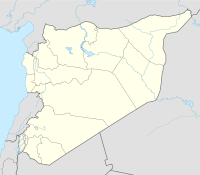Emar
| Alternate name | Tell Meskene (Arabic: تل مسكنة) |
|---|---|
| Location | Near Maskanah, Aleppo Governorate, Syria |
| Region | Lake Assad shoreline |
| Coordinates | 35°59′12.63″N 38°6′40.95″E / 35.9868417°N 38.1113750°E |
| Type | settlement |
| History | |
| Abandoned | 1187 BC |
| Cultures | Amorite |
| Satellite of | Ebla, Yamhad, Carchemish |
| Site notes | |
| Excavation dates | 1972—1976 1996—2002 |
| Archaeologists | Jean-Claude Margueron |
| Ownership | Public |
| Public access | Yes |
Emar (modern Tell Meskene) is an archaeological site in Aleppo Governorate, northern Syria. It sits in the great bend of the mid-Euphrates, now on the shoreline of the man-made Lake Assad near the town of Maskanah. It has been the source of many cuneiform tablets, making it rank with Ugarit, Mari and Ebla among the most important archeological sites of Syria. In these texts, dating from the 14th century BC to the fall of Emar in 1187 BC, and in excavations in several campaigns since the 1970s, Emar emerges as an important Bronze Age trade center, occupying a liminal position between the power centers of Upper Mesopotamia and Anatolia-Syria. Unlike other cities, the tablets preserved at Emar, most of them in Akkadian and of the thirteenth century BC, are not royal or official, but record private transactions, judicial records, dealings in real estate, marriages, last wills, formal adoptions. In the house of a priest, a library contained literary and lexical texts in the Mesopotamian tradition, and ritual texts for local cults.
Emar was strategically sited as a trans-shipping point where trade on the Euphrates was reloaded for shipping by overland route. In the middle of the third millennium BC Emar came under the influence of the rulers of Ebla; the city is mentioned in archives at Ebla. In Mari texts of the eighteenth century BC, (Middle Bronze Age), Emar was under the influence of the neighboring Amorite state of Yamhad. There was no local tradition of kingship at Emar. For the thirteenth and the early twelfth centuries BC (Late Bronze Age), there is written documentation from Emar itself, mostly in the Akkadian language, and also references in contemporaneous texts from Hattusa, Ugarit, and in Assyrian archives; at the time Emar was within the Hittite sphere of influence, subject to the king of Carchemish, a Hittite client-king. It was the chief city of a Hittite border province known as the Land of Astata which included Tell Fray. Correlating the kings of Emar with the known king-list of Carchemish provides some absolute dating.
...
Wikipedia

